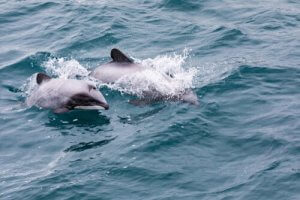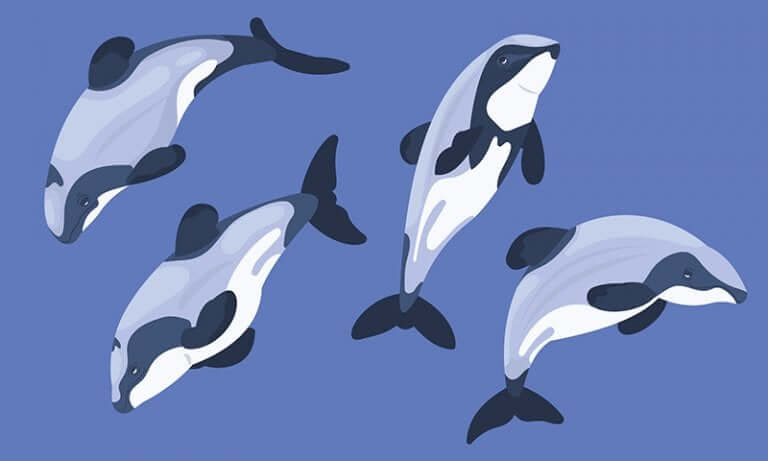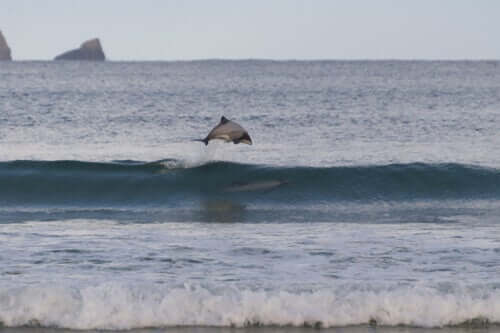Hector's Dolphin: Native to New Zealand

Hector’s dolphin is a species of dolphin native to New Zealand. Its scientific name is Cephalorhynchus hectori, hence the common name “Hector’s dolphin.”
Characteristics of Hector’s dolphin
This species has the robust characteristics of the Delphinidae family. But it’s also the smallest known species in this family. It has a slight degree of sexual dimorphism, where the males are a bit bigger than the females. Adults can reach about 4-5 feet long, and weigh about 88-132 pounds.
The Hector’s dolphin has a light gray head, with some areas of black. It has a kind of black band that goes from the top, where it has a black mask around its eyes, and then towards the back of its body. The part that starts right behind the black spot on its lower jaw is white, as is the area just behind their fins and in their genital area.
Their fins, rounded dorsal fin, the area around their blowhole, and a lot of the spots around that go from dark gray to black. Their snouts have a black spot and aren’t very long. They have about 24-31 teeth in each row of their jaws.
Although they may look mostly gray, if you ever get close to one of these dolphins in the daylight, you’ll see that they have a lot of different shades on their body.

Population and distribution
Hector’s dolphin is a species native to New Zealand. This species is extremely limited geographically, more so than any other species of dolphin. There are also two subspecies of it.
You’ll mostly see Hector’s dolphins in the southern and western waters of the islands, near shallow waters in the summer. They tend to spread out a bit more in the winter.
Subspecies
The species Cephalorhynchus hectori has two different subspecies:
- Cephalorhynchus hectori hectori. This is the main subspecies, and it lives around the southern side.
- Cephalorhynchus hectori maui. These live around the northeast, and are also called “Maui’s dolphin.”
The two subspecies are separated by the deep waters of the Cook Strait and the southeastern point of the Southern island. You mostly see these two subspecies in the summer, about 6 miles off the coast. It’s not common to see them in the winter.
There have also been some reported sightings in Australia and Malaysia. However, for the moment these seem to have been false sightings caused by errors of identification.
There are also some slight differences between the two subspecies. The most obvious is that Maui’s dolphin has a smaller dark patch around its penis, if it has a dark patch it all. Maui’s dolphin is also slightly bigger than Hector’s dolphin.

The conservation of Hector’s dolphin
In 2008, the IUCN (International Union for Conservation of Nature) put it on its red list because of the drastic reduction in population over the past 40 years. Being on the red list means the species is endangered.
Of the two subspecies of Hector’s dolphin, it’s Maui’s dolphin that’s truly in critical risk of extinction.
The main threat to them is accidental capture by fishermen (in net-fishing or trawling). Some estimates put the reduction in their population in recent years at 50%. With that in mind, conservationists created a reserve at the Banks Peninsula in 1988, where they’ve banned net-fishing. That has helped reduce the number of accidental captures.
Other dangers include:
- Injuries caused by ship propellers.
- Fishing, and a reduction in space for them to swim.
- Pollution of the waters from farm and forest runoff.
- Changes to their habitat.
- Illness. Brucellosis is a bacterial condition that can reduce Hector’s dolphins’ reproduction rates.
Fun facts about Hector’s dolphin
It’s easy to confuse them with other types of dolphins like the common dolphin, bottlenose dolphin, or even some species of whale, like the southern right whale. But you can tell these apart once you notice how complex their colors are.
The freediver William Trubridge was named ambassador to Maui’s dolphins. His goal was to bring awareness to the importance of conserving every species if we want to keep the biosphere healthy.
This species is very active and playful, and like waves. They eat crustaceans and small fish. To capture their prey, they have to do quick dives, no longer than 90 seconds. So, why not take a trip to New Zealand next December (their summer) and try to catch a glimpse of these amazing dolphins?
Hector’s dolphin is a species of dolphin native to New Zealand. Its scientific name is Cephalorhynchus hectori, hence the common name “Hector’s dolphin.”
Characteristics of Hector’s dolphin
This species has the robust characteristics of the Delphinidae family. But it’s also the smallest known species in this family. It has a slight degree of sexual dimorphism, where the males are a bit bigger than the females. Adults can reach about 4-5 feet long, and weigh about 88-132 pounds.
The Hector’s dolphin has a light gray head, with some areas of black. It has a kind of black band that goes from the top, where it has a black mask around its eyes, and then towards the back of its body. The part that starts right behind the black spot on its lower jaw is white, as is the area just behind their fins and in their genital area.
Their fins, rounded dorsal fin, the area around their blowhole, and a lot of the spots around that go from dark gray to black. Their snouts have a black spot and aren’t very long. They have about 24-31 teeth in each row of their jaws.
Although they may look mostly gray, if you ever get close to one of these dolphins in the daylight, you’ll see that they have a lot of different shades on their body.

Population and distribution
Hector’s dolphin is a species native to New Zealand. This species is extremely limited geographically, more so than any other species of dolphin. There are also two subspecies of it.
You’ll mostly see Hector’s dolphins in the southern and western waters of the islands, near shallow waters in the summer. They tend to spread out a bit more in the winter.
Subspecies
The species Cephalorhynchus hectori has two different subspecies:
- Cephalorhynchus hectori hectori. This is the main subspecies, and it lives around the southern side.
- Cephalorhynchus hectori maui. These live around the northeast, and are also called “Maui’s dolphin.”
The two subspecies are separated by the deep waters of the Cook Strait and the southeastern point of the Southern island. You mostly see these two subspecies in the summer, about 6 miles off the coast. It’s not common to see them in the winter.
There have also been some reported sightings in Australia and Malaysia. However, for the moment these seem to have been false sightings caused by errors of identification.
There are also some slight differences between the two subspecies. The most obvious is that Maui’s dolphin has a smaller dark patch around its penis, if it has a dark patch it all. Maui’s dolphin is also slightly bigger than Hector’s dolphin.

The conservation of Hector’s dolphin
In 2008, the IUCN (International Union for Conservation of Nature) put it on its red list because of the drastic reduction in population over the past 40 years. Being on the red list means the species is endangered.
Of the two subspecies of Hector’s dolphin, it’s Maui’s dolphin that’s truly in critical risk of extinction.
The main threat to them is accidental capture by fishermen (in net-fishing or trawling). Some estimates put the reduction in their population in recent years at 50%. With that in mind, conservationists created a reserve at the Banks Peninsula in 1988, where they’ve banned net-fishing. That has helped reduce the number of accidental captures.
Other dangers include:
- Injuries caused by ship propellers.
- Fishing, and a reduction in space for them to swim.
- Pollution of the waters from farm and forest runoff.
- Changes to their habitat.
- Illness. Brucellosis is a bacterial condition that can reduce Hector’s dolphins’ reproduction rates.
Fun facts about Hector’s dolphin
It’s easy to confuse them with other types of dolphins like the common dolphin, bottlenose dolphin, or even some species of whale, like the southern right whale. But you can tell these apart once you notice how complex their colors are.
The freediver William Trubridge was named ambassador to Maui’s dolphins. His goal was to bring awareness to the importance of conserving every species if we want to keep the biosphere healthy.
This species is very active and playful, and like waves. They eat crustaceans and small fish. To capture their prey, they have to do quick dives, no longer than 90 seconds. So, why not take a trip to New Zealand next December (their summer) and try to catch a glimpse of these amazing dolphins?
All cited sources were thoroughly reviewed by our team to ensure their quality, reliability, currency, and validity. The bibliography of this article was considered reliable and of academic or scientific accuracy.
- Dawson, S. M. 2002. Cephalorhynchus dolphins Cephalorhynchus spp. In: W. F. Perrin, B. Wursig and J. G. M. Thewissen (eds), Encyclopedia of Marine Mammals, pp. 200-204. Academic Press. Online: https://books.google.es/books?id=TwFUimDtz7sC&pg=PA553&dq=Dawson,+S.+M.+2002.+Cephalorhynchus+dolphins+Cephalorhynchus+spp.+In:+W.+F.+Perrin,+B.+Wursig+and+J.+G.+M.+Thewissen+(eds),+Encyclopedia+of+Marine+Mammals,+pp.+200-204.+Academic+Press&hl=es&sa=X&ved=0ahUKEwjsiLuhuPXiAhXN8OAKHasqAfoQ6AEIKDAA#v=onepage&q=Cephalorhynchus%20dolphins%20&f=false
- Reeves, R.R., Dawson, S.M., Jefferson, T.A., Karczmarski, L., Laidre, K., O’Corry-Crowe, G., Rojas-Bracho, L., Secchi, E.R., Slooten, E., Smith, B.D., Wang, J.Y. & Zhou, K. 2013. Cephalorhynchus hectori. The IUCN Red List of Threatened Species 2013: e.T4162A44199757. http://dx.doi.org/10.2305/IUCN.UK.2013-1.RLTS.T4162A44199757.en. Downloaded on 19 June 2019.
- https://www.wwf.es/?21680/Los-delfines-de-Maui-al-filo-de-la-extincin
- Dawson, S.M. Cephalorhynchus Dolphins: C. heavisidii, C. eutropia, C. hectori, and C. commersonii. Enclyclopedia of Marine Mammals, pp. 166-172. 3ªEd. Academic Press. (2018). https://doi.org/10.1016/B978-0-12-804327-1.00086-8. Online: https://www.sciencedirect.com/science/article/pii/B9780128043271000868
-
Buckle K, Roe WD, Howe L, Michael S, Duignan PJ, Burrows E, et al. Brucellosis in Endangered Hector’s Dolphins (Cephalorhynchus hectori). Vet Pathol. 1 de septiembre de 2017;54(5):838-45. Online: https://journals.sagepub.com/doi/full/10.1177/0300985817707023
This text is provided for informational purposes only and does not replace consultation with a professional. If in doubt, consult your specialist.








